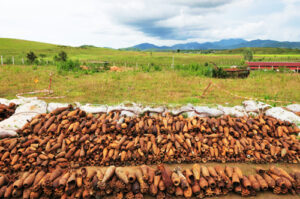 From 1964 to 1973, the U.S. dropped more than two million tons of ordnance on Laos during 580,000 bombing missions—equal to a planeload of bombs every 8 minutes, 24-hours a day, for 9 years – making Laos the most heavily bombed country per capita in history. The bombings were part of the U.S. Secret War in Laos to support the Royal Lao Government against the Pathet Lao and to prohibit traffic along the Ho Chi Minh Trail. The bombings destroyed many villages and displaced hundreds of thousands of Lao civilians during the nine-year period. Up to a third of the bombs dropped did not explode, leaving Laos contaminated with vast quantities of unexploded ordnance (UXO). Over 25,000 people have been killed or injured by UXO in Laos since the bombing ceased.
From 1964 to 1973, the U.S. dropped more than two million tons of ordnance on Laos during 580,000 bombing missions—equal to a planeload of bombs every 8 minutes, 24-hours a day, for 9 years – making Laos the most heavily bombed country per capita in history. The bombings were part of the U.S. Secret War in Laos to support the Royal Lao Government against the Pathet Lao and to prohibit traffic along the Ho Chi Minh Trail. The bombings destroyed many villages and displaced hundreds of thousands of Lao civilians during the nine-year period. Up to a third of the bombs dropped did not explode, leaving Laos contaminated with vast quantities of unexploded ordnance (UXO). Over 25,000 people have been killed or injured by UXO in Laos since the bombing ceased.
The Hidden Danger
 We are often asked, “Why Laos?†There are several reasons but none as important as this issue. Cluster munitions were primarily used in bombing runs, each bomb releasing hundreds of smaller bomblets. These small bombs, known as bombies by the Laos people, are around 3 lbs each and look like toys. According to www.legaciesofwar.org, about one third of the land in Laos is contaminated with unexploded ordinance. Many of these bomblets have become buried in the earth waiting for unexpected farmers or the monsoon rains to uncover them. Many farmers in Laos know their land is contaminated but are unable to afford their removal. They simply have no choice but to cultivate their land even with the dangers that may lie below.
We are often asked, “Why Laos?†There are several reasons but none as important as this issue. Cluster munitions were primarily used in bombing runs, each bomb releasing hundreds of smaller bomblets. These small bombs, known as bombies by the Laos people, are around 3 lbs each and look like toys. According to www.legaciesofwar.org, about one third of the land in Laos is contaminated with unexploded ordinance. Many of these bomblets have become buried in the earth waiting for unexpected farmers or the monsoon rains to uncover them. Many farmers in Laos know their land is contaminated but are unable to afford their removal. They simply have no choice but to cultivate their land even with the dangers that may lie below.
The Story that Hits From Laos to Home
For our team at Mission Arabica this “unearthed†problem became a reality last year when Zach, our friend who is working in Laos, had a very real and very personal encounter with this problem. Below is the story Zach sent me last fall from his experience:
“A group of boys were playing in the jungle together in a distant outside village in Laos (ranging from 4-13 years old) Because of the rainy season, an old unexploded bomb unearthed itself from the soil. The boys found the bomb and thought it was some kind of toy (Sidenote: These kind of bombs detonate based on the number of rotations it has experienced on it’s flight down from an airplane. If the plane was flyig to low to the ground than the bombs would simply hit the ground and do nothing. If the bombs had enough time to rotate then the detonation would occur.) The boys played with the bomb rather freely, throwing it around for the day. Unfortunately, because the boys were throwing the bomb around it had the opportunity to rotate. When the bomb eventually detonated there were five boys within it’s vicinity. One boy was immediately killed from the blast. Two made off with shrapnel wounds, minor cuts, and burns. The two others were deeply wounded with their intestines hanging from their abdomen. The four boys who had survived were rushed to the nearest city with a hospital (Luang Prabang, 5-6 hours from their village)
In attempts to get the boys medical care, friends and family pooled together what little funds they had and took them to the army hospital in Luang Prabang (LP). This happens to be the cheapest and (..for lack of better words.. ) most dangerous hospital in LP. Their equipment, their cleanliness, ect. is all minimal. When I arrived on the scene the boys with the issue of their intestines already had some kind of surgery. However, one of the boys, a 4 year old little guy had gone into sceptic shock after the surgery. We helped take them to the main hospital in town where the boys could receive better care. The main surgeon did not like what he saw in the small boy and was convinced that he developed his sceptic shock condition because of the lack of cleanliness at the other hospital.
Even though this was the best hospital in town, they told us that they don’t know how to take care of little children and couldn’t do much more for him. We advised the family to let us send him to the capital where there are pediatricians, but the family refused. They wanted to take him back to their village so he could die in the village. This is an old tradition in Laos, that if you die outside of the village you are unable to bring the body back into the village. They wanted to bury him in their village. Because he remained alive for two days the family finally agreed on the transport to the capital, but by then it was too late. The main surgeon said he wouldn’t be able to travel anywhere. One day later the little 4 year old boy died. The rest of the boys recovered quickly and today are doing fine. The other boy who died in the initial blast of the bomb was 13 years old.â€
With Power Comes Responsibility
So what can you and Mission Arabica do about this together? There is already a lot of money being sent from the US government to help with clearing all the ordinance left behind, way more than what we could hope to send or do. By Laos being a farming community is where our opportunity lies. With the monetary opportunity coffee presents to the Laos farmers it will mean an increase in education and awareness as well as access to better health facilites. Rice is the main crop for Lao farmers. As stated in an earlier blog article, Why Laos, coffee is a much more sustainable and profitable crop. Not only that, but rice requires entire fields to be turned over every year, raising the risk for finding these bombs. Coffee plants do not require this and they never have to till the ground over and over every year like they would have to with rice.
A lot of “littles” adds up to “A lot”
The other thing we can do is to just continue to raise awareness. Without sounding over-dramatic, we as Americans do have responsibility to help the Lao people in regards to what we intentionally did there with these munitions. In an article written in the Huffington Post, Rep Michael Honda stated, “We have a moral obligation to fix this problem…It’s time we followed through on that commitment and solved this problem once and for all.â€
How can you help now? You can start by sharing this blog article. Zach’s story to us is very personal and is a driving force in helping the people of Laos out. Also, you can continue to support us, Mission Arabica, in any way possible. For ideas on how to do this please visit our “help out†page.
Final quick facts:
o Ov er 270 million cluster bombs were dropped on Laos during the Vietnam War (210 million more bombs than were dropped on Iraq in 1991, 1998 and 2006 combined); up to 80 million did not detonate.
er 270 million cluster bombs were dropped on Laos during the Vietnam War (210 million more bombs than were dropped on Iraq in 1991, 1998 and 2006 combined); up to 80 million did not detonate.
o Nearly 40 years on, less than 1% of these munitions have been destroyed.More than half of all confirmed cluster munitions casualties in the world have occurred in Laos.
o Each year there continue to be over 100 new casualties in Laos. Close to 60% of the accidents result in death, and 40% of the victims are children.
o Between 1995 and 2013, the U.S. contributed on average $3.2M per year for UXO clearance in Laos; the U.S. spent $13.3M per day (in 2013 dollars) for nine years bombing Laos.
Thank you for sharing this post. It is eye opening to learn about this huge problem. I wonder how they go about clearing the UXO. This company comes to mind. http://www.gp-radar.com